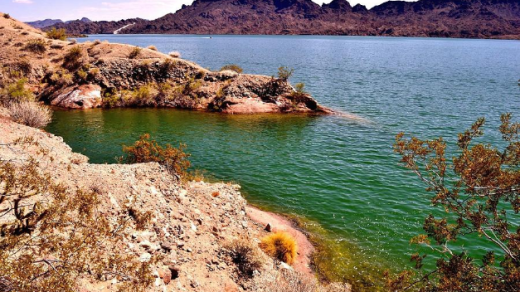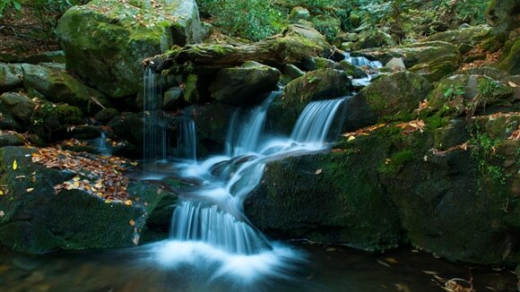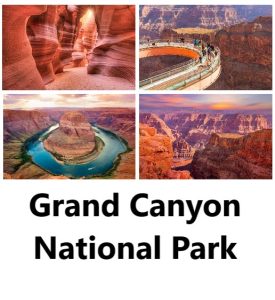Brief Introduction:
Established in 1933, White Sands National Park is renowned for its vast and surreal landscape of glistening white sand dunes. Covering 275 square miles of desert in New Mexico, it boasts the world’s largest gypsum dune field, offering a unique and otherworldly experience to its visitors.
Natural Beauty Landscapes:
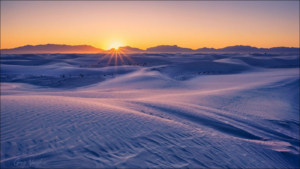
- Gypsum Sand Dunes: The heart of the park, these magnificent white dunes transform the landscape into an almost alien terrain, with dunes rising and falling like waves in a gypsum sea.
- Interdune Areas: Between the dunes, hard-packed soil supports a variety of life, and visitors can find pockets of vegetation and animal tracks, revealing the park’s thriving ecosystem.
Flora and Fauna:
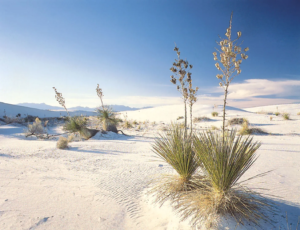
The park is home to a surprising array of plant and animal life adapted to its harsh, fluctuating conditions. Over 800 species of fauna, including the bleached earless lizard, a species that has evolved to blend into the pale sands, can be found here. Among the flora, the soaptree yucca stands tall, its roots delving deep into the shifting sands for moisture.
Camping and Accommodations:

- Camping: Backcountry camping permits allow for overnight stays amidst the dunes, offering a serene and starlit experience. There are no developed campgrounds within the park, emphasizing a rugged and natural experience.
- Lodging: Nearby towns such as Alamogordo and Las Cruces provide a range of lodging options from hotels to bed and breakfasts, catering to visitors seeking comfort after a day of exploration.
Tips for Visitors:
- Reservations: While the park does not offer reservations for camping, it’s essential to check in at the visitor center for backcountry permits.
- Permits: Required for backcountry camping.
- Weather: The desert can be extremely hot during the day and surprisingly cold at night. Prepare accordingly.
- Wildlife: Enjoy wildlife from a distance. Do not feed animals and be aware of the sensitive desert ecosystem.
Hiking and Trails:
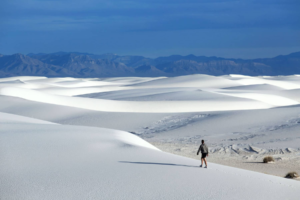
- Interdune Boardwalk (Easy): A short, accessible boardwalk that offers stunning views of the dune field and the surrounding mountains, perfect for all visitors.
- Alkali Flat Trail (Moderate): A 5-mile round trip that takes hikers to the heart of the dune field, offering a challenging but rewarding experience.
- Backcountry Camping Trail (Challenging): For those looking to camp among the dunes, this trail leads to designated backcountry camping areas, offering solitude and unparalleled night skies.
What to Expect:
Visitors should be prepared for an environment that is as beautiful as it is harsh. The dunes offer little shade, and the sun can be intense. The experience varies with the seasons, with spring and fall offering milder temperatures and the chance to witness the unique flora and fauna in more comfortable conditions.
Seasonal Attractions and Best Times to Visit:
- Spring: Cooler temperatures make this a perfect time for hiking and photography, with the added bonus of wildflowers after sufficient rainfall.
- Summer: Despite the heat, early mornings and late afternoons in summer provide incredible light for photography and cooler temperatures for exploring.
- Fall: Mild weather and fewer visitors make fall an ideal time for a peaceful visit.
- Winter: The park is quieter, and the contrast of the white dunes against clear blue skies can be striking.
Special Events:
White Sands National Park hosts full moon nights where the park remains open after dark, allowing visitors to experience the dunes under the glow of the moonlight, creating a magical and unforgettable experience.
Protecting the Park:
Respect the fragile ecosystem by staying on designated trails, packing out all trash, and not disturbing the wildlife. The park’s unique landscape is a treasure that requires our care to preserve its beauty for future generations.
Getting There and Around:

Located near Alamogordo, NM, the park is accessible via US Highway 70. The nearest airports are in El Paso, Texas, and Albuquerque, New Mexico, each offering car rentals for the scenic drive to the park.
White Sands National Park, is famous for its striking landscape of white gypsum sand dunes that stretch as far as the eye can see. This surreal and beautiful environment has not only attracted visitors from all over the world but has also caught the eye of filmmakers, serving as a backdrop for various movies due to its unique and otherworldly scenery.
Several movies have been filmed at White Sands National Park, taking advantage of its vast, unspoiled landscapes that can stand in for alien planets, desert scenes, or simply provide a breathtaking setting. Some notable films shot in this location include:

- “Transformers” (2007): This blockbuster, directed by Michael Bay, used White Sands as a stand-in for an alien landscape in several scenes.
- “Year One” (2009): Directed by Harold Ramis, this comedy adventure featuring Jack Black and Michael Cera included scenes shot in the dunes of White Sands, contributing to the film’s prehistoric and untouched world.
- “Book of Eli” (2010): This post-apocalyptic tale starring Denzel Washington utilized the stark, barren landscapes of White Sands to represent a devastated world.
The park’s unique natural features not only provide a stunning visual experience for visitors but also offer an intriguing and versatile location for filmmakers looking to capture a sense of vastness, isolation, or the beauty of the natural world. White Sands National Park remains a testament to the natural wonders of the United States and continues to inspire both nature lovers and creative minds alike.


